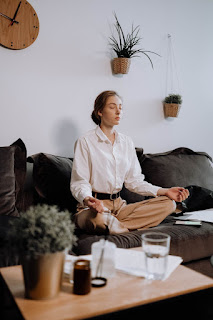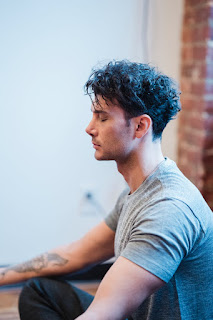First Steps into Silence: A Beginner’s Guide to Meditation
Meditation is not merely an exercise in stillness but a deep dive into the silence that resides within us all. This guide is crafted for those who wish to acquaint themselves with this serene practice, offering a pathway to peace amidst the chaos.
Beginning your meditation journey requires nothing more than a willingness to pause and a curiosity to explore the silence that meditation reveals. This guide unfolds as an accessible entry point into the world of meditation, emphasizing its relevance and simplicity. Meditation, after all, is about nurturing a space of quiet within, a sanctuary where the mind can rest and rejuvenate.

We will walk through the foundational aspects of meditation, introducing the philosophy that underpins this practice and providing practical steps for those taking their first steps. From setting a meaningful intention to exploring beginner-friendly meditation techniques, this guide is designed to gently usher you into a practice that has the power to transform your relationship with silence and stillness.
The Essence of Silence: Discovering Meditation
In a world where distractions are endless, seeking silence can seem like searching for a rare gem. However, meditation isn’t about finding silence in the environment around us; rather, it’s about uncovering a deep, intrinsic quietness within ourselves.
What is Meditation?
At its core, meditation is the art of introspection. It’s a process where you deliberately shift your focus from the external chaos to the calm within. This practice involves:
- Mindfulness: Being fully present in the moment, aware of where we are and what we’re doing, without judgment.
- Concentration: Focusing your attention on a single point, like your breath, a mantra, or a particular object. This helps in quelling the mind’s tendency to wander.
- Relaxation: Allowing your body to relax, which naturally follows when you start to quiet the mind.
What to Expect from Meditation:
- A Journey, Not a Destination: Meditation isn’t about achieving a state of perpetual peace but learning to navigate through your thoughts and emotions with more ease.
- Variability: Some sessions might feel deeply tranquil, while others might be filled with thoughts. This variability is normal and part of the learning process.
- Awareness of Self: Over time, meditation can lead to greater self-awareness, helping you understand your thought patterns, triggers, and emotions better.
- Emotional Regulation: As you become more familiar with your inner landscape, you’ll likely notice an improved ability to manage stress, anxiety, or negative emotions.
- Physical Benefits: Many find that meditation leads to lower blood pressure, improved sleep, and even pain management.
- Silence Within: You’ll learn to access a silence that isn’t the absence of sound but a profound, peaceful presence that coexists with external noises. This internal silence can be a sanctuary amidst the cacophony of life.
- Patience and Practice: Like any skill, meditation requires patience and regular practice. The benefits often accumulate gradually, but the journey can be transformative.
Meditation, therefore, is not just about finding moments of silence; it’s about cultivating an ongoing relationship with your inner self, learning to listen to the quiet beneath the noise, and using that understanding to live more fully in each moment.
Understanding the Roots of Meditation
Meditation has been a cornerstone of spiritual and contemplative practices across various cultures and traditions for thousands of years. Its roots are as diverse as humanity itself, stretching from the ancient Vedic texts of India to the Zen traditions of East Asia, and even to the mystical branches of Western religions. At its core, meditation is about consciousness and awareness, a means to explore the very nature of our being and our place in the universe.
The Philosophical Underpinnings
Philosophically, meditation invites us to ponder the nature of our thoughts, emotions, and the transient nature of existence. It teaches us to observe our experiences without attachment, allowing us to gain insights into the workings of our minds and the reality that surrounds us. This philosophical approach is not about acquiring knowledge in the traditional sense but about experiencing a state of being that transcends the ordinary.
The Practice: A Journey Inward
The true practice of meditation begins with a simple yet profound step: the intention to be present. It’s about setting aside time for stillness, to breathe, and to listen to the silence that envelops every moment. This journey inward is marked by a gradual peeling away of the layers of noise—both external and internal—that cloud our experience of the present.
Silence in meditation is not merely the absence of sound but the presence of an expansive stillness that offers a respite for the mind. It’s in this space of silence that we find clarity, insight, and a deeper connection to ourselves. Meditation teaches us to cultivate this silence, to make it a sanctuary where we can retreat from the turmoil of the external world.

The Benefits: Beyond the Silence
Engaging in regular meditation practice unveils a multitude of benefits that extend far beyond the moments of stillness. It enhances our mental, emotional, and physical well-being, fostering a sense of inner peace that permeates our daily lives. From reducing stress and anxiety to improving focus and creativity, the benefits of meditation are as profound as they are varied.
As we embark on this journey into silence, we begin to realize that meditation is more than a practice—it’s a way of being. It’s a path that leads us to discover the boundless peace that resides within, waiting to be uncovered.
First Steps: How to Begin Your Meditation Practice
Embarking on a meditation practice can feel like stepping into a new world, one filled with the promises of peace and self-discovery. However, knowing where to begin can often be the most challenging part. Here are some foundational steps to help you start your meditation journey on the right foot.
Setting Your Intentions
Before diving into the practice, it’s crucial to set clear intentions. Ask yourself why you want to meditate. Is it for peace of mind, emotional balance, increased focus, or perhaps to explore the depths of your inner self? Understanding your motivation will guide your practice and help you stay committed.
Choosing the Right Time and Place
Consistency is key in meditation. Choose a time of day when you can be undisturbed and calm, whether it’s in the early morning or just before bed. The place where you meditate should be quiet, comfortable, and free from interruptions. It doesn’t have to be an elaborate setup—a simple corner of your room with a cushion or chair will do.
Starting Small
Begin with short sessions, about 5-10 minutes a day, and gradually increase the duration as you become more comfortable with the practice. Starting small helps build the habit without feeling overwhelmed.
Embracing Simplicity
Your initial meditation sessions should focus on the basics. Begin by paying attention to your breath, noticing the inhalation and exhalation, and the sensations it brings. This simple act of focusing on your breath serves as an anchor for your mind, helping to bring your attention back to the present whenever it wanders.
Being Patient and Kind to Yourself
It’s normal for your mind to wander during meditation, especially in the beginning. When you notice your thoughts drifting, gently guide your focus back to your breath without judgment. Meditation is a practice of patience and kindness towards oneself.
Reflecting on Your Experience
After each session, take a moment to reflect on your experience. Notice any shifts in your mood, thoughts, or physical sensations. This reflection can provide valuable insights into your practice and help you adjust as needed.
As you continue to meditate regularly, you’ll find that each session deepens your understanding and appreciation of the practice. Remember, meditation is a journey, not a destination. Each step, no matter how small, is a step towards greater peace and self-awareness.

Meditation Techniques for Beginners
As you embark on your meditation journey, exploring different techniques can help you find the approach that best suits your needs and preferences. Here are some beginner-friendly techniques to consider:
Focused Attention Meditation
This method involves focusing your attention on a single point. This could be your breath, a specific word or mantra, a candle flame, or even a simple visual object. The goal is to practice directing your focus back to your chosen point of attention whenever your mind wanders. Focused attention meditation is a powerful way to enhance your concentration and calm your mind.
Mindfulness Meditation
Mindfulness meditation encourages you to observe wandering thoughts as they drift through your mind. The intention is not to get involved with the thoughts or to judge them, but simply to be aware of each mental note as it arises. By observing these thoughts, you learn not to attach to them but to watch them, gaining insight into the patterns of your mind.
Body Scan Meditation
Body scan meditation involves paying attention to various parts of the body and bodily sensations in a gradual sequence from head to toe. This practice encourages you to scan your body for areas of tension and to allow them to relax. It promotes bodily awareness and relaxation, making it particularly beneficial for those new to meditation.
Walking Meditation
Walking meditation turns the simple act of walking into a meditative practice. It involves focusing on each step and the sensations of walking, such as the feel of your feet touching the ground. This technique can be particularly helpful for those who find stillness challenging and prefer to incorporate movement into their practice.
Loving-Kindness Meditation (Metta)
Loving-kindness meditation focuses on developing feelings of goodwill, kindness, and warmth towards others. It often involves silently repeating phrases that express wishes for well-being and happiness for oneself and others. This practice can help to foster a positive attitude and reduce negative emotions.
Experiment and Explore
Each of these techniques offers a unique path to the same destination: greater peace, clarity, and mindfulness. Beginners are encouraged to experiment with these different methods to discover what resonates most. Remember, there is no “right” way to meditate; what matters most is consistency and finding joy in your practice.

Incorporating Meditation into Your Daily Routine
Making meditation a regular part of your daily life might seem daunting at first, but with some simple strategies, it can become as routine as brushing your teeth. Here’s how you can integrate meditation into your everyday activities:
Set a Specific Time for Meditation
Consistency is key when building a new habit. Choose a specific time for your meditation practice each day, whether it’s in the morning to start your day with clarity or in the evening to unwind. Sticking to the same time helps solidify the habit.
Keep It Short and Sweet
In the beginning, it’s more effective to meditate for a shorter duration that you can commit to daily than to aim for longer sessions that are hard to maintain. Even just 5-10 minutes a day can have a profound impact on your well-being.
Use Reminders and Alarms
In our busy lives, it’s easy to forget our commitment to meditation. Setting reminders or alarms on your phone or leaving visual cues in places you’ll see daily can help keep your practice top of mind.
Create a Dedicated Space
Having a specific spot where you meditate can enhance your practice. This doesn’t need to be an elaborate setup; a quiet corner with a comfortable seat is all you need. The consistent setting helps your mind associate that space with meditation and calmness.
Incorporate Mindfulness into Daily Activities
Meditation doesn’t have to be confined to sitting in silence. You can practice mindfulness throughout the day by bringing full attention to whatever you’re doing, such as mindful eating, walking, or even during chores. This helps cultivate a meditative mindset beyond the cushion.
Be Flexible and Forgiving
Some days, finding time to sit down for meditation might not be possible. When this happens, be flexible. A few minutes of deep breathing or a mindful moment can also be beneficial. The key is to maintain a non-judgmental and forgiving attitude towards yourself.
Connect with a Community
Joining a meditation group or finding friends who also meditate can provide motivation and support. Sharing experiences and tips can enrich your practice and help keep you accountable.
Celebrate Your Progress
Recognize and celebrate the milestones in your meditation journey. Acknowledging the positive changes in your mood, stress levels, or overall sense of well-being can motivate you to continue.
By weaving meditation into the fabric of your daily life, you’ll find that its benefits extend far beyond the moments of practice. It becomes a tool for living more consciously, calmly, and with greater presence in every moment.

Overcoming Common Challenges in Meditation
Beginning a meditation practice is an exciting step towards self-discovery and inner peace. However, like any new endeavor, it’s not without its challenges. Here are some common obstacles beginners face and strategies to overcome them:
Dealing with Distractions
Challenge: Whether it’s external noise or internal chatter, distractions are a common hurdle in meditation.
Solution: Accept that distractions are a part of the meditation process. Instead of fighting them, gently redirect your focus back to your meditation object (like your breath or a mantra) each time you notice your mind wandering. With practice, you’ll find it easier to maintain your focus.
Finding Time to Meditate
Challenge: With busy schedules, finding time to meditate can sometimes feel impossible.
Solution: Start with short sessions, even just five minutes a day, and gradually increase as you get more comfortable. Remember, quality over quantity is key in building a sustainable practice. Also, try integrating mindful moments into your day-to-day activities as a way to cultivate awareness.
Physical Discomfort
Challenge: Sitting in one position for a period can be uncomfortable, especially in the beginning.
Solution: Ensure you’re in a comfortable position before starting your practice. You don’t have to sit in a lotus position; sitting on a chair or lying down is also acceptable. Make small adjustments as needed, but try to remain still once you’ve found a comfortable pose.
Doubting the Process
Challenge: It’s common to question whether you’re “doing it right” or if meditation is even working.
Solution: Meditation is a personal journey, and there’s no one “right” way to practice. Trust the process, and be patient with yourself. Benefits can be subtle at first but will become more apparent with regular practice.
Maintaining Consistency
Challenge: Keeping up with a regular meditation practice amidst life’s ups and downs can be challenging.
Solution: Set realistic goals and remind yourself why you started meditating. Connecting with a community or meditation group can also provide motivation and support to maintain consistency.
Handling Restlessness
Challenge: Feeling restless or bored during meditation is a common experience.
Solution: Acknowledge these feelings without judgment and bring your attention back to your meditation focus. With time, you’ll learn to observe restlessness without being swept away by it.
Emotional Discomfort
Challenge: Meditation can sometimes bring up unexpected emotions or thoughts.
Solution: Approach any emotions that arise with curiosity and compassion. Meditation offers a safe space to observe these feelings without attachment, allowing for healing and insight.
By understanding and preparing for these common challenges, you can navigate the early stages of your meditation practice with confidence and resilience. Remember, every practitioner faces hurdles along the way; overcoming them is part of the journey toward deeper awareness and peace.





